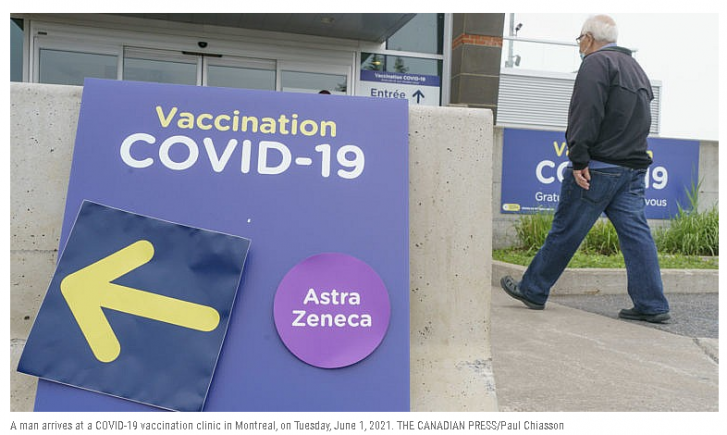Vaxx Populi: Researchers are getting faster at recognizing, diagnosing and treating VITT, and there is hope that they’re zeroing in on what causes it
As Ontario, Nova Scotia and other provinces distribute second doses of the AstraZeneca vaccine to residents, there is good news about the troubled COVID-19 vaccine. Not only are doctors and researchers around the world getting faster at recognizing, diagnosing and treating the rare blood clotting syndrome that can occur after a shot of the vaccine, but there is now hope that scientists are zeroing in on what causes vaccine-induced immune thrombotic thrombocytopenia (VITT). The syndrome, which can occur between four and 28 days after vaccination, features both blood clots and low platelet counts. And it’s those tiny blood cells, which work by forming blood clots to stop bleeding, that are key to identifying VITT in patients.
Researchers at Goethe University in Germany think they may have found a solution to the VITT problem. They believe the issue is with how the vaccine delivers the spike protein of the SARS-CoV-2 virus into the body. In rare cases, it doesn’t bind to the cell membrane but is released into the bloodstream where it interacts with antibodies and causes clotting events. If proved right, the Goethe scientists believe the vaccine could be tweaked to avoid that occurrence, and thus stop VITT.

In Canada, VITT is diagnosed at the McMaster Platelet Immunology Laboratory (MPIL) in Hamilton, Ont.. It’s the only lab in the nation capable of confirming VITT. Physicians send clinical information about patients who might have the syndrome to the laboratory and then ship blood samples, explains Dr. Ishac Nazy, the lab’s director and an associate professor at McMaster University. It’s a two step-process. First the lab does a screening test, looking for a specific type of antibody. That test takes a few hours of lab work. If it’s negative, the patient doesn’t have VITT.
If it’s positive, lab personnel run a functional platelet-activating test. The test was originally developed at the McMaster lab to look for heparin-induced thrombocytopenia (HIT), which activates platelets that can form blood clots. Scientists realized that VITT acts in a similar fashion (but doesn’t require heparin as a trigger). If the patient has activated platelets, then they have VITT. MPIL then informs the doctors, so they can continue treating the person for the syndrome.
VITT is very rare. In Canada, it occurs in roughly one in every 58,000 people who got a first dose of AstraZeneca, though that ratio is below one in 20,000 in Scandinavia. For second doses, the ratio is roughly one in 600,000, according to data in Britain, where tens of millions of AstraZeneca doses have been administered.
“For every case that we identify, we are testing tens and hundreds of samples. We want to make sure we don’t miss any,” Nazy says. “So we advise the doctors that if you suspect it and have the slightest evidence it is VITT, send it our way.”
There have been around 30 cases of VITT in Canada and five deaths as of late May. With increasing awareness of its symptoms—which can include headaches and shortness of breath in that crucial window after vaccination—more cases are being caught and treated earlier. A few months ago, the risk of dying from VITT was 60 to 80 per cent; it’s now around 20 per cent, Nazy wrote in an article about second doses that he co-authored for The Conversation.
There are no known confirmed risk factors for VITT, though females of child-bearing years appear to have a slightly elevated risk, Nazy says. More science is needed to identify why those individuals are getting clots. In time, he thinks researchers might be able to identify a biomarker, but wonders, as VITT is so rare, whether it would be practical to test everyone before they got a vaccine linked to the syndrome, like AstraZeneca.
While the German scientists are optimistic about their findings and the possibility of tweaking the AstraZeneca vaccine, Nazy is cautious. “It’s very, very early and very very possible,” he says. He points out that, while the researchers in Frankfurt have shown the first step in a lab, a lot of science is still needed.
But the breakneck pace of scientific breakthroughs during this pandemic does give Nazy hope that a solution to VITT will be found. “What I’ve learned in the last 14 or 15 months of COVID is how incredible science is when it is backed with finance and urgency,” he says. “So I would not be surprised if we figure it out in the next year.”
As Canada rolls out the country’s most complex vaccination project to date, Maclean’s presents Vaxx Populi, an ongoing series in which Patricia Treble tackles the most pressing questions related to the new COVID-19 vaccines. Send us a question you’d like answered at vaccines@macleans.ca. If you have specific questions about your own health, we recommend consulting a family doctor or the local public health authority in your area.
Article From: Maclean’s
Author: Patricia Treble

